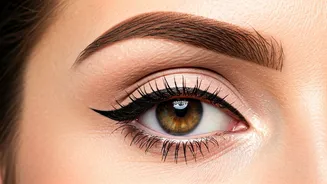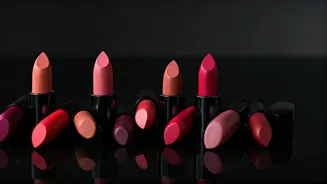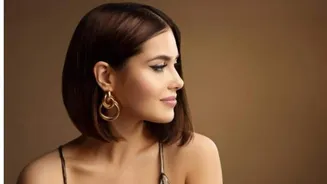The Waterline Eyeliner
In the 1960s, the waterline eyeliner was a cornerstone of eye makeup. The application involved lining the inner rim of the lower eyelid, usually with a dark
pencil. This technique created the illusion of fuller lashes and a more defined eye shape. Various colors were used, though black and navy were the most popular choices. The waterline eyeliner was frequently paired with other techniques, like the use of eyeshadow and mascara, to achieve a cohesive, retro look. It was a key element in the overall dramatic aesthetic of the era. The application required a steady hand and a keen eye for detail, making it a makeup staple that elevated any look. It was a simple yet effective way to add intensity.
Straight Eye Shadow
Straight eyeshadow application was a popular technique in the 60s, a look easily achieved using a single eyeshadow shade. The shadow was applied directly across the eyelid, from the lash line to the crease. The edges could be blended for a softer effect, or kept sharp for a more graphic look. Common colors included pastels like blue, green, and pink, as well as classic browns and grays. This method was often paired with thick eyeliner and bold mascara to complete the eye makeup. The simplicity of the straight eyeshadow application made it an accessible style that was easy to replicate. This approach offered a clear, uniform look that emphasized the shape of the eye and the color of the eyeshadow.
Hooded Eyeliner Wing
Eyeliner wings for hooded eyes were meticulously crafted during this era, playing a significant role in defining the eye shape. The technique adapted the wing to suit the specific eye structure, focusing on creating a lifted effect. Rather than extending the wing directly outward, it was often angled upwards to counteract the hooded shape. This ensured the wing was visible when the eyes were open and created a flattering silhouette. The wing's thickness and length were carefully adjusted based on personal preference and eye shape. This tailored approach was crucial in achieving an elegant and impactful eye look that worked harmoniously with hooded eyelids. The goal was to enhance, not obscure, the natural eye contour.
Eyelid Highlight
Highlighting the eyelid was a subtle yet effective method to brighten the eyes in the 1960s. This involved applying a lighter eyeshadow or shimmer to the center of the eyelid. This highlighted the eye's natural contours. The chosen highlight shade was usually a light cream, white, or a pastel color. It created an effect that made the eyes appear more open and awake. This technique was often combined with other aspects of eye makeup, like dark eyeliner and mascara, creating a balanced and enhanced look. The eyelid highlight was a simple technique that had a significant visual impact, making the eyes pop and adding a touch of radiance to the makeup.
Bold Eyelashes
In the 1960s, bold eyelashes were an essential component of the eye makeup look, amplifying the overall drama. Mascara, both black and sometimes in other colors, was applied liberally to both the upper and lower lashes. The goal was to create volume, length, and a defined appearance. False lashes were popular and essential for achieving the most impactful look. The use of false lashes was especially significant. They came in various styles, from natural-looking to dramatic and voluminous. Mascara and false lashes combined to create a striking effect that drew attention to the eyes. This combination perfectly captured the era's focus on exaggerated features. It was a key element in achieving the signature 60s eye.
The Smokey Eye
The Smokey eye had an early iteration in the 1960s, showcasing a softer approach. Unlike the modern dramatic styles, the 60s smokey eye was generally more subtle. It was achieved by blending dark eyeshadows, typically charcoal grey or brown, across the eyelid and slightly beyond the crease. This softened look was often paired with a light or neutral eyeshadow on the brow bone to create contrast and lift. The aim was to create depth and definition without a heavy look. The technique required careful blending to avoid harsh lines. It was a less intense version of the classic smokey eye that emphasized a more subdued yet alluring look. It added depth to the eyes.
Soft Smoke
The soft smoke variant of the smokey eye involved creating a diffused effect. The blending was key in this style. This look used shades of gray, brown, and sometimes even hints of purple, blended seamlessly. The technique involved applying the darker shade to the outer corner of the eye and then blending it inward to achieve a gradient. This softer approach was intended to enhance the eyes without overwhelming the face. A touch of highlight under the brow arch and along the lower lash line helped to complete this look. It was a sophisticated and versatile style that could be adapted for both day and night looks. This technique focused on a delicate blend, creating a less dramatic version that was suitable for everyday wear.
The Socket Smoke
The socket smoke technique in the 60s involved applying a darker eyeshadow to the eye socket. This created the illusion of depth and added a dimension to the eye. The eyeshadow was carefully blended along the natural crease of the eye, creating a shadowed effect. This technique was often combined with other elements like eyeliner and mascara to complete the eye look. This style was designed to enhance the natural eye shape and add a touch of drama, emphasizing the eyes’ contours. Careful blending prevented any harsh lines and created a seamless transition of color. The socket smoke was an effective method to add definition and intensity to the eyes. This adds visual interest and a sophisticated touch.
Reverse Eyeliner
Reverse eyeliner was a trend in the 1960s. This technique involved applying eyeliner to the lower lash line only. The eyeliner was often a dark color, like black or navy, and the line was extended outwards to create a more defined eye shape. It was a less conventional way of applying eyeliner that contrasted the traditional upper eyeliner application. This bold look was often paired with neutral or light eyeshadows on the upper lids to balance the lower lash line. This technique created a dramatic look that drew attention to the lower lash line. The reverse eyeliner technique offered a distinct and eye-catching appearance, changing how eyeliner was applied.
Mini Eyeliner Wing
Mini eyeliner wings became a popular trend, offering a subtle yet impactful way to define the eyes. Instead of a full wing, the eyeliner was extended slightly beyond the outer corner of the eye. This provided a touch of drama without being overly bold. The length and thickness of the wing could be customized based on preference. This subtle wing created an upward lift to the eye. This style was an accessible way to add a hint of flair, perfect for those wanting a touch of retro charm without going overboard. The mini wing allowed for a more subtle look, yet it still captured the essence of 60s style.








